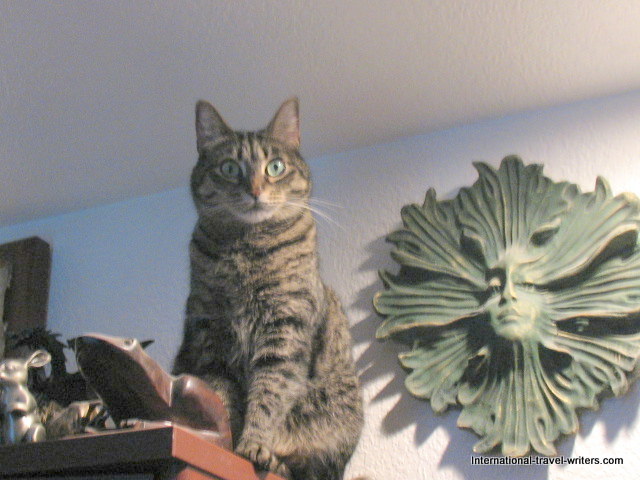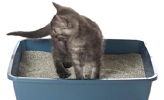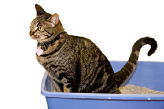The Feline Urinary Tract

Feline urinary tract health is vital to your precious pet. Cats have flourished in the domestic animal world in recent years and it is partly due to their self-suffiency. You don't have to run home from work to let them outside to do their business or take them out for a walk so they can attend to "business". Cats have an inherent urge to bury their urine and feces in dirt or sand so it is important to ensure comfortable indoor litter box availability.
Four anatomical components make up the feline urinary tract system: two kidneys, two ureters, the bladder and the urethra. The kidneys are the blood’s secretion and filtration system, and they maintain the body’s hydration level. Blood circulates through kidneys where water is reabsorbed and a waste product called urine is eliminated.
Normal kidneys produce urine constantly. The amount depends on how much the pet drinks, how much wet food it eats, environmental temperature, activity level and the cat’s general health. Also, there are vitamin substances which help maintain feline urinary tract health.
Urine drains from the kidneys through the ureters. Each kidney has its own ureter, which is responsible for transporting urine to the bladder. The bladder, which is the reservoir for storing urine, stretches and fills up like a water balloon as urine enters.
When the bladder becomes full, nerves in the bladder sense filling and send impulses to the pet’s brain. The brain responds by sending impulses back, allowing the bladder to contract and the cat to urinate. The passageway from the bladder to outside the cat’s body is called the urethra.
Male and female urethras differ in structure. The female cat has a short, straight, wide urethra that empties out of the vagina. The male has a long, narrow, curing urethra that empties through the penis. These anatomical differences account for the different problems that affect the male and female feline urinary tract. A good example is the urinary blockage that occurs in male cats.
Diseases affecting the feline urinary tract are grouped according to the problem’s location. Some problems are medical, while others are behavioral. Age, breed, diet and lifestyle... all affect feline urinary tract performance. Many urinary tract diseases exist, but I’ll only cover the most common.
Kidney, or renal dysfunction can be life threatening. Waste products that are not adequately eliminated from a cat’s body will rise to high levels in the blood and make the animal sick. Decreased kidney function is the most common metabolic problem in cats over the age of 10. Kidneys are unable to regenerate so tissue damage is generally irreversible.
The animal body is a great machine. If 50 percent of kidney function (meaning one kidney) is present, the body works well. Changes in urine concentrating ability, which is determined by urinalysis, and waste product buildup in the blood, which is determined by blood test, are not even detected until more than two-thirds of kidney function has been lost.
Signs of kidney disease include increased water intake, increased urination, decreased appetite, listlessness, weight loss and dehydration. Any of these signs should warrant an examination by your veterinarian. If the vet suspects kidney disease, he or she will perform urinalysis and blood testing.
Damaged kidneys are unable to
concentrate urine. Instead of filtering out waste products and
conserving water in the body, too many waste products stay in the blood
and too much water leaves.
The duration of kidney dysfunction impacts response to treatment.
Acute, meaning rapid onset, kidney disease has a better chance of
responding than chronic, long-standing disease. Treatment involves
flushing the body with large amounts of intravenous fluids. Diuretics,
antibiotics, mineral supplements, binders and low protein diets are also
used. Response is measure by the decrease in blood waste products.
The prognosis for any cat with kidney disease is guarded and progress is measured one day at a time. Cats that fail to respond adequately to medical treatment may be candidates for kidney transplantation, but this can be impractical and/or costly.
The kidney wears out faster than the cat’s other organs. Chronic kidney dysfunction occurs in older cats. The good news is that if an older cat is diagnosed with kidney disease and is still in relatively good physical condition, it can potentially be treated for years.
Owners may even regularly give their cats fluid injections at home, which helps keep the blood’s waste product level down and offers the animal a good quality of life. At some point, though, the kidney disease will progress, and the fluid injections will not be enough to keep the cat comfortable.
Cats can be born with bad kidneys. Examples of congenital conditions are renal amyloidosis, which is seen in a small number of Abyssinian cats, or polycystic kidneys, which is seen rarely in Persians, Himalayans and mixed-breed kittens with longhair genes. It is not normal for a cat under 10 years of age to have kidney disease. Other than congenital disease, infections, metabolic imbalances and toxins can cause renal disease in young cats.
Antifreeze or air conditioning coolant, for example, is sweet to drink but with a few hours can kill kidney tissue. Owners of outdoor cats should watch for leakage of this fluid from their cars. A less toxic antifreeze made out of propylene glycol versus the common, toxic ethylene glycol, is available.
Kidney disease is a serious condition. Each cat will respond differently to treatment. Your vet should be able to assess your cat’s test results and discuss the options available. One parameter for assessing and monitoring kidney function is the BUN, or blood urea nitrogen. Dehydration and decreased renal function can increase levels of this compound which is a breakdown product of protein metabolism in the body.
Feeding a cat with kidney disease a restricted protein diet can help to lower this value. Special vet diets formulated for cats with kidney disease are available. Commercial diets labeled as formulated for feline urinary tract disease are usually designed for bladder disease, not kidney disease, so read carefully. If you have a cat that will not eat a restricted diet, you may try a senior, mature, geriatric, light or less active diet.
Feline lower urinary tract disease is a broad name for problems affecting the bladder and urethra. Previously, these conditions were called FUS, feline urologic syndrome, but the terminology was not specific for the location. Causes of FLUTD can be bacterial, viral, idiopathic, (occurring without any known cause), interstitial cystitis (inflammation of the bladder), bladder stones and urethral blockage.
Of these conditions, feline urinary tract blockage is the most serious. Some forms of FLUTD are curable, while others need long-term management. For further details on FLUTD please see Feline Lower Urinary Tract Disease the article that deals with all the specifics.
Bladder stones form similarly to rock candy. Crystals clump, then form layers on top of one another resulting in a small stone. Cats generally form only a few stones at a time, but handfuls of stones have been seen in some cats. Treatment options will depend upon whether urinalysis and x-rays provide good evidence of the stone type. Years ago, a type of stone called struvite, a combination of magnesium, ammonia and phosphate minerals…was the most common.
A vet can prescribe a diet that, if fed exclusively may cause the stone to dissolve within two months. The diet lowers the pH of the urine, making it more acidic. The acidic urine prevents the minerals that make up struvite to form the crystals. The diet is restricted in magnesium, an important mineral in struvite formation. If the stone does not shrink within a month of dietary treatment, then it is likely to be of a non-dissolvable type. If the stone does dissolve, then a special maintenance diet formulated to prevent stone recurrence is recommended.
Some very small stones in female cats can be expelled by a procedure called urohydropropulsion. Most stones that cannot be dissolved are surgically removed. Once a stone has been removed, it should be sent to a lab for analysis. By knowing the stone’s chemical makeup, curative or preventive measures can be taken. Over the past ten years there has been an increase in the number of calcium oxalate stones in cats.
Researchers believe overuse of acidifiers in feline diets has caused this stone type. Diet alone cannot dissolve calcium oxalate stones. Cats that develop these stones are likely to form them again, though diet and supplement therapy can reduce the recurrence rate of this problem of the feline urinary tract.
Overuse of urinary acidifiers can also lead to kidney disease by lowering feline urinary tract health. Older cats commonly experience decreased renal function as they are, and acid urine is more of a strain on older kidneys. An average cat will urinate twice a day with conscious and unconscious controls regulating the elimination.
When the brain recognizes that the bladder is full, the conscious controls signal the cat to go the litter box and eliminate. Cats that eliminate outdoors find appropriate locations when signaled by their conscious controls. It a cat is startled or scared and urinates on the spot, the unconscious controls have taken over.
Ten percent of cats will eliminate inappropriately during their lifetime. When a cat urinates outside its litter box, the urine should be analyzed for medical problems. If the urine is normal, then a behavior problem is likely.
Often, may cats will urinate outside their litter
boxes to alert their owners to a problem or to get attention. Before
you blame your cat for misbehaving, make sure that an underlying medical
problem does not exist.
Behavioral problems related to the feline urinary tract are spraying and house soiling,
both of which are inappropriate elimination. Behavioral causes for
those behaviors range from territorial marking to stress to a dirty
litter box. Behavioral problems are more common in multi-cat
households. To help prevent problems, multiple litter boxes are needed,
as is litter box cleanliness. Some cats also have litter type
preferences, so a simple change of litter may alleviate the problem.
Many vets deal with the behavioral issues themselves while others may refer patients to an animal behaviorist. Depending on the situation, behavior modification and drug therapies may be used. Early intervention is important but not every cat can be cured. Trying to understand why the cat has developed the problem is important for reaching a solution.
Human anti-anxiety drugs are being used more frequently to control these behavioral problems. Use of these drugs may be long term, since they are not tested on cats, they should be used only under veterinary supervision. The risks associated with them may be considerably lower than those associated with hormone treatments used in the past.
Cats with a feline urinary tract that is functioning normally will have consistent litter box routines. A change is a signal that there may be a medical or a behavioral problem so before you scold your cat, give it the benefit of a vet checkup. Some feline urinary tract problems can be treated while others can be fatal. Work with your vet to help ensure the feline urinary tract health of your little critter.
Related Articles......
Return from Feline Urinary Tract to Cat Health Detective Homepage
Having trouble finding what you need? Cat Health Index & Site Map
OR
Do you have a question to ask?...Questions
OR
Do you have a cat story to share?...Simply click here to go to that page!
Copyright@2010-2020 All rights reserved.Cat-health-detective.com
This website is information only. Consult a veterinarian for medical assistance

"Like Us" on Facebook
or...
"Like Us" here




















